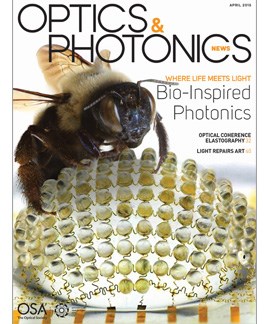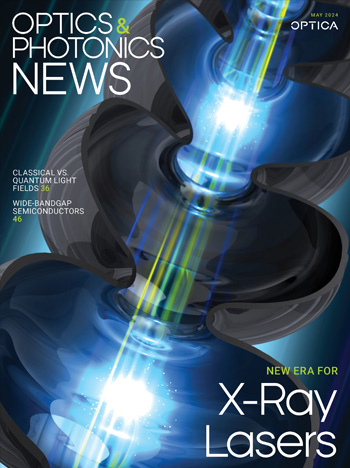
April 2015 Issue
Feature Articles
Where Life Meets Light: Bio-Inspired Photonics
Inspired by the results of natural selection, scientists are designing new and improved optoelectronic systems modeled after the way animals, insects and plants use light.
by Valerie C. CoffeyOptical Coherence Elastography
OCE provides 3-D maps of tissue stiffness on the micrometer to millimeter scale, bridging a crucial gap in probing the mechanical properties of diseased tissues.
by Brendan F. Kennedy, Kelsey M. Kennedy and David D. SampsonLight Repairs Art: Optical Overlays Restore Faded Masterworks
Light or oxidation degrades dyes and pigments, altering artworks over the years and centuries. With some new techniques, art conservators can use light to restore the faded glory of a masterpiece without changing the original.
by Jeff HechtDepartments and Columns
Scatterings
Headliners, policy news, industry updates and book reviews.
The Times They Are a-Changin’
Lesley Cohen, a professor at Imperial College London, provides a perspective on the cultural changes supporting gender equality at universities in the United Kingdom.
A Half-Trillion-Dollar Industry
As Tom Hausken notes, OSA’s estimate of world optics and photonics revenues for 2014 involves making some decisions about what constitute “optics-enabled products.”
Frequency Combs: Optimization for Precision Metrology
Q&A with Curtis Menyuk, one of the hosts of the OSA Incubator Meeting, “Quantitative Modeling of Frequency Comb Sources.”

![Infinity Mirrored Room– Brilliance of the Souls 2014 by artist Yayoi Kusama. [© YAYOI KUSAMA]](https://opnmedia.blob.core.windows.net/$web/opn/media/images/articles/2024/0724/departments/202407-cover-web.jpg?ext=.jpg)
![An experimental scheme demonstrated by researchers at Princeton and Yale universities, USA, can convert physical noise into errors that can be corrected more easily. [F. Wojciechowski, Princeton University]](https://opnmedia.blob.core.windows.net/$web/opn/media/images/articles/2024/0624/departments/202406-cover-web.jpg?ext=.jpg)
